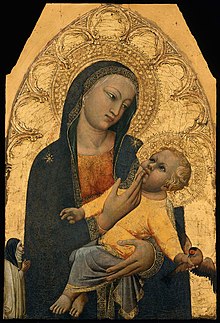Antonio Veneziano (painter)
Antonio Veneziano , also Antonio di Francesco da Venezia and Antonio Viniziano , was an Italian late Gothic painter who is documented between 1369 and 1388. The name came gradually from Giorgio Vasari from Venice and worked in Florence , Siena and Pisa .
Life
He was a student of Taddeo Gaddi . According to documents, he worked for the cathedral in Siena in 1369/70, he is mentioned in Florence in 1374 and in Pisa between 1384 and 1386, where he completed frescoes about the life of San Ranieri in the Camposanto Monumentale . They had been started by Andrea da Firenze and were badly damaged by bombing during World War II. According to Vasari, that made him a name and he was well rewarded before returning to Florence. There he painted frescoes in the Basilica of Santa Maria Novella (Spanish Chapel) in Florence.
His works include a Madonna in the Museum of Fine Arts in Boston and a beheading of John the Baptist in the Museo dell'Opera del Duomo di Firenze . With Andrea Vanni he painted on altarpieces, including a Marian triptych with two saints. According to Vasari, he is said to have painted frescoes in the Doge's Palace in Venice, but after he was badly paid there after Vasari he decided to stay in Florence in the future. He also painted for the Acciaiuoli in the Certosa San Lorenzo di Galluzzo (Vasari).
According to Vasari, he was the teacher of Gherardo Starnina . In 1374 he is registered in Florence in the guild of pharmacists and doctors. Most recently, according to Vasari, he is said to have worked as a medicinologist and doctor. He studied the Dioscurides and distilled herbal brews and experimented a lot. According to Vasari, he died in Florence in 1384 of a stomach ailment or a plague epidemic that was rampant at the time. However, the date of death cannot be correct: his last known work is a panel painting dated and signed in 1388 for the Brotherhood of S. Nicolò Reale in the Diocesan Museum of Palermo . The name can be proven in documents in Florence until 1419, but it is not certain whether it is not a painter of the same name.
A throne Maria with music-making angels is in the Lower Saxony State Museum in Hanover.
Web links
| personal data | |
|---|---|
| SURNAME | Veneziano, Antonio |
| ALTERNATIVE NAMES | Antonio Veniziano; Antonio Viniziano; Antonio di Francesco da Venezia |
| BRIEF DESCRIPTION | Italian painter |
| DATE OF BIRTH | before 1369 |
| PLACE OF BIRTH | Venice |
| DATE OF DEATH | after 1388 |

